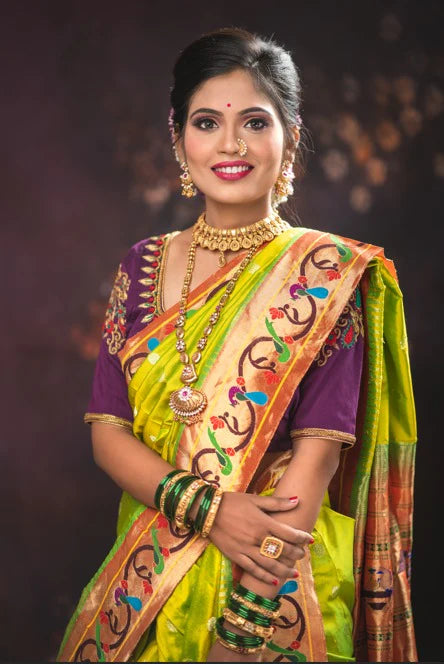A Beginner’s Guide to Draping a 9-Yard Saree in Different Regional Styles
- Posted by Manish Kumar

A Beginner’s Guide to Draping a 9-Yard Saree
The 9-yard saree, also known as "Navvari" or "Madisar," is an iconic symbol of India's rich cultural heritage. This traditional saree offers a variety of draping styles, each reflecting the unique traditions and lifestyles of different regions. For beginners, exploring these styles is not only a journey through history but also an opportunity to embrace timeless elegance. Let’s dive into some popular regional draping styles and tips for mastering them.
1. Maharashtrian Nauvari Style
- Significance: Worn during festive occasions and traditional ceremonies, especially by Maharashtrian brides and dancers.
- Key Features: The saree is tucked at the back, passed through the legs, and draped over the shoulder to resemble a dhoti.
-
Steps:
- Start by tucking the saree at the back and bringing it forward.
- Pass the pleats through the legs and tuck them at the back again.
- Drape the pallu over the left shoulder.
- Tip: Use safety pins to secure the pleats for ease and comfort.
2. Tamil Madisar Style
- Significance: Typically worn by Tamil Brahmin women during religious ceremonies and weddings.
- Key Features: This style is tied like a pantsuit, allowing ease of movement.
-
Steps:
- Divide the saree into two portions and wrap one around the waist like a skirt.
- Bring the other half through the legs and tuck it at the back.
- Pleat and drape the pallu over the left shoulder.
- Tip: A cotton 9-yard saree works best for this style as it holds the drape better.
3. Madurai Kattukacham
- Significance: Popular among traditional communities in Tamil Nadu, this style is practical and elegant.
- Key Features: It involves tight pleats and a front tuck resembling trousers.
-
Steps:
- Start by wrapping the saree around the waist and tucking it in.
- Create tight pleats at the front and pass the remaining fabric between the legs.
- Secure the pallu around the waist and over the shoulder.
- Tip: Practice the pleating technique to achieve a neat finish.
4. Brahmini Style
- Significance: Common in South Indian ceremonies.
- Key Features: This style combines elegance with religious symbolism.
-
Steps:
- Wrap the saree like a skirt and tuck it in the back.
- Pull the remaining portion through the legs and secure it at the waist.
- Drape the pallu gracefully over the left shoulder.
- Tip: Use silk sarees for a luxurious and traditional look.
5. Coorgi Style
- Significance: Worn by the Kodava women of Karnataka.
- Key Features: The pleats are placed at the back, and the pallu is draped over the front.
-
Steps:
- Wrap the saree around the waist and pleat it backward.
- Bring the pallu over the front and pin it neatly.
- Secure it on the left shoulder for a distinctive look.
- Tip: Add a decorative belt to enhance the style.
General Tips for Beginners:
- Fabric Choice: Start with lightweight cotton or semi-silk sarees for easy handling.
- Practice: Spend time practicing in front of a mirror to build confidence.
- Accessories: Use saree belts and pins to secure the drape.
- Comfort: Choose styles that allow free movement and comfort for your specific occasion.
Mastering the art of draping a 9-yard saree is a rewarding experience that connects you to India's diverse traditions. With practice, you’ll discover the beauty and versatility of this timeless attire. So, embrace your heritage, and let the 9-yard saree become your canvas of self-expression.
